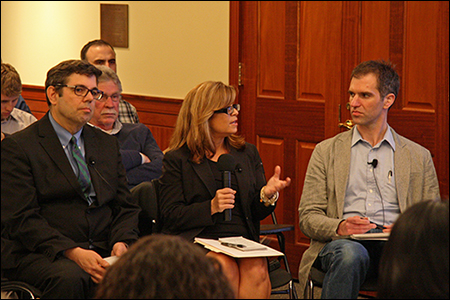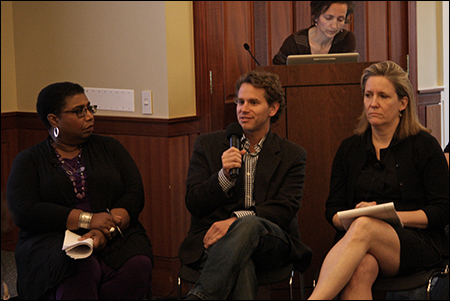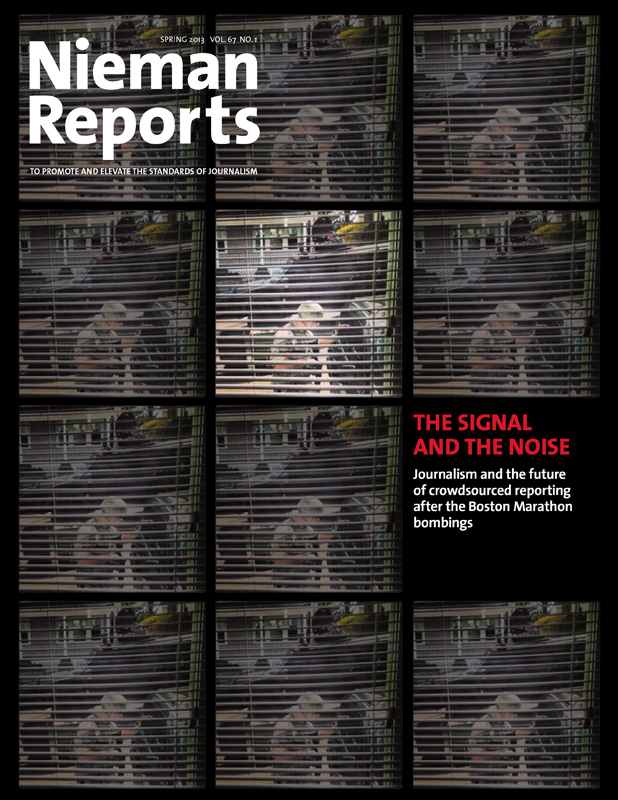
From left, David Beard, Cheryl Fiandaca, and Seth Mnookin, speaking at the Nieman Foundation on May 1. Photo by Jonathan Seitz
"One of the things that's happening with Twitter is the whole process of what we do is being demystified. Now it's much easier to see that we don't have some secret journalistic mind control that allows us to get people to talk to us. We're just out there talking to people, or we're people who happen to be there at the right time. One way that we can increase our credibility as journalists is to become more transparent about how we're getting information."
So said Seth Mnookin, co-director of MIT's Graduate Program in Science Writing, during a panel discussion called "Journalism & the Boston Marathon Bombings" hosted by the Nieman Foundation for Journalism at Harvard on May 1. Mnookin was joined by Boston Globe reporter David Abel, Globe deputy managing editor for local news Jennifer Peter, WGBH radio host Callie Crossley, Washington Post director of digital content David Beard, and Boston Police public information officer Cheryl Fiandaca. James Geary, deputy curator of the Nieman Foundation, was the moderator.
Mnookin learned all about transparency on Twitter during the manhunt for the suspects. When he received a campus alert about a shooting at MIT on the Thursday after the bombing, he jumped into his car and rushed to the scene. He didn't have an assignment or a deadline to meet, but he continually updated his 8,500 followers about what was happening. By Friday morning, as people awoke to a metropolis in lockdown, that follower count exceeded 46,000.
His tweets served as his notes when he wrote up the experience for The New Yorker's website. A magazine writer and former newspaper reporter, Mnookin remembered that in the past the notes he’s taken on the scene were typically illegible. Using Twitter as a notebook, he said, gave him a time-stamped record of what he'd done that night, where he'd been, and what he'd seen.
The ability to use Twitter as a tracking tool was also highlighted by MIT researcher Todd Mostak, who presented his Massively Parallel Database (MaPD), which allows him to pull in tweets based on geography or subject matter and show how information spreads across the country and world. MaPD can also plot the route that Mnookin took by showing the geolocated tweets of Taylor Dobbs, a Northeastern University student who was traveling with Mnookin and had his iPhone’s geolocation option turned on.
"Any time you tweet on your cell phone with GPS enabled, it’s probably being pulled into my database, for better or worse," Mostak said.
One of the other Twitter-related technologies demonstrated at the event was Keepr, an algorithm-based search tool developed by visiting Nieman Fellow Hong Qu that can find credible sources quickly. That tool helped him find Mnookin's coverage of the manhunt, which he said he followed throughout the night.

From left, Callie Crossley, David Abel, and Jennifer Peter, speaking at the Nieman Foundation on May 1. Photo by Jonathan Seitz
Traditional media also made extensive use of Twitter and other social media to report the story. 2013 Nieman Fellow David Abel was working on a documentary film project at the Marathon finish line when the bombs went off. He continued shooting video in the chaos, but stopped to send out a message saying he was OK. "That tweet seemed to go viral," Abel said, and he soon was being called by TV producers from ABC and NBC to the BBC and Radio New Zealand.
He used Twitter to report a story for the Globe about Sean Collier, the MIT police officer who was shot and killed on Thursday night, sparking the region-wide manhunt. Abel said Twitter helped him find sources and communicate with people, but it also gave him a very different outlet for his writing, one that isn't usually available to newspaper reporters.
"It allowed me to write in a more personal way and to sort of vent and connect with a growing number of people about what I experienced, how it affected me, and what I was seeing," Abel said.
The Washington Post's David Beard, a former staffer at the Globe, said his paper mobilized to cover the story from afar. Staffers had to deal with "basic language issues; for the first five hours or so, it was 'blast' or 'explosion,'" until an official source confirmed that it was a bombing, he said.
Crossley, who hosts local radio show "Under the Radar" and anchored public radio station WGBH's coverage during the week, echoed Beard’s concerns about using the right language. She also pointed out that, in such times of crisis, local radio stations can play an important community role in their coverage. WGBH made the decision to forego NPR's national broadcast, instead extending its own programming.
"Our job as a community radio program offering information for everybody is really to assess and coalesce all of the information that's been shared here, and to repeat it constantly, in a way that's not annoying to people," Crossley said. "I was, frankly, surprised at how many people just had basic questions that they wanted answered, and they felt a need to want to connect to someone like us, who they felt they could trust to give them credible information."
For official organizations like the Boston Police Department, social media became a way to keep in touch with citizens and update the media. Former television reporter Cheryl Fiandaca, who now runs the Boston Police Department’s Twitter feed, among other duties, said the stakes are much higher when you're serving as an official source.
"Being a reporter, you have responsibilities," Fiandaca said. "In this job, you are responsible. For me, that meant that we couldn’t make any mistakes. We couldn't put out any information that we weren't 100 percent sure of. That was a really tough balance, because as everybody knows that's ever covered a news story, it's breaking news and it's developing and what you think is true right this minute might not be true ten minutes from now."
During the manhunt, a firefight broke out in front of the Watertown home of entrepreneur Andrew Kitzenberg. While all three of his roommates took cover in their closets, he took photos of the shootout with his phone and posted them to Twitter.
"At the time, I really wasn't thinking as a journalist," said Kitzenberg, who was in the audience for the event and noted that he does not have a background in journalism. "I really wasn't thinking a whole lot, I'd say. … While I was trying to take pictures and ultimately document it, I wasn't thinking like a journalist to try to give my opinion, it was more so explaining what I saw."
His pictures were seen by Dana Forsythe, editor of the Watertown Tab. He contacted Kitzenberg and quickly posted the photos on the newspaper's website. Forsythe, also at the event, said that he relied on two stringers in the area, Adam Sennott and Garrett Quinn, to report the story, and was able to use Twitter to augment their coverage because the paper already followed so many Watertown residents.
Beard said the week's coverage was an eye opener for him about the new opportunities for journalists. "I'm absolutely delighted that there's a broader base to distribute what's important to a broader group of people." he said, though there were a number of mistakes made by news outlets throughout the process. He closed the event by offering three pieces of advice for news organizations:
"One: Have a coverage plan. Two: Antenna up for new tools and sources. And three: Verify, verify, verify."



